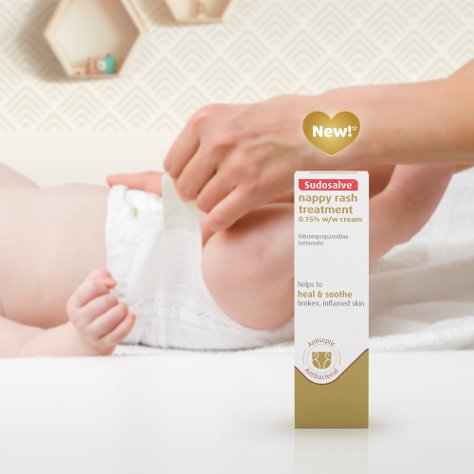Severe nappy rash: What you need to know
Nappy rash is very common in babies, but how do you know if your baby is suffering from severe nappy rash and what should you do? Here are some tips to help

Nappy rash is very common in babies’ lives. At some point in their first two years, many babies are likely to have a case of nappy rash at some point. Usually, this is nothing to worry about and will clear up on its own but there are some things you can do to help.
Sudocrem is a household name when it comes to nappy rash with preventative or treatment options to soothe, protect and heal nappy rash.
To help prevent nappy rash before it develops, you can use a barrier cream such as Sudocrem Care & Protect. Its triple-action, hypoallergenic formula is gentle enough to be used at every nappy change to help protect delicate skin against infection.
If nappy rash does develop, classic Sudocrem Antiseptic Healing Cream has been there for parents for over 85 years to help soothe baby. It’s clinically proven to soothe and treat nappy rash and gets to work fast*. It can be used as often as needed to help ease symptoms of nappy rash.
Sudocrem have also recently launched a new member of the Sudocrem family, Sudosalve Nappy Rash Treatment Cream which helps to soothe and heal broken and inflamed skin. It’s antibacterial, antifungal and antiseptic to help clear and prevent secondary infections. Sudosalve is easy to apply, gliding over skin helping to minimize discomfort to your baby. It applies transparent, and also won’t discolour your baby’s clothing.
What if my baby suffers with severe nappy rash?
Severe nappy rash, while uncomfortable for your baby, is more common than most people think. Babies have very sensitive skin, and it can be affected in many ways, even with all of the right precautions, changing methods and skin cleaning routines. Sometimes you can do everything right, and problems will still arise.
There are some clear signs to look out for if your baby has developed a severe case of nappy rash, they include:
- Your baby being in discomfort
- The skin being very hot to the touch.
- The skin being very swollen, with very sore looking patches or lines where the skin has broken.
- Tiny red spots appearing, or bumps that resemble ringworm (this could be a sign of a fungal infection).
If you see signs of severe nappy rash, it is best to see your GP or talk to your health visitor as soon as you are able. They will be able to give you the best advice for the particular severe nappy rash that your baby is experiencing, and prescribe any creams or medicine necessary to help treat it (for example, if the rash is caused by a bacterial infection, then your GP may prescribe antibiotics).
Understandably, it may not be possible to see your GP right away if, for example, you’ve noticed the rash becoming more severe in the middle of the night. In this case, it’s important to follow these steps to ensure that your baby’s discomfort isn’t increased in the meantime – before you can contact your GP or health visitor:
- Do not apply your regular barrier cream or ointment, until you have spoken to your GP or heath visitor, especially if you suspect a fungal infection (you see red spots as described above).
- Try and keep your baby out of their nappy as much as possible and get air to the area of the rash. If you are at home, you can lay your baby down on a towel or, if they are old enough to move around, move them to a warm room with an easy to clean floor.
- Don’t use soap, bubble bath, lotions or talc.
If you see any other types of rashes appearing, or are still concerned about the original rash, then check the NHS visual guide to baby rashes on the NHS website, and follow their instructions. You can call NHS 111 if you are concerned. If you suspect meningitis, as described on the NHS visual guide, then this is a medical emergency and you should Call 999 for an ambulance or go to your nearest A&E immediately.
*Within 24h. Based on SURE study of 2159 respondents, Feb 2015
Sudocrem Antiseptic Healing Cream. Always read the label.
Sudosalve Nappy Rash Treatment Cream. Contains Dibrompropamidine isetionate. Always read the label.